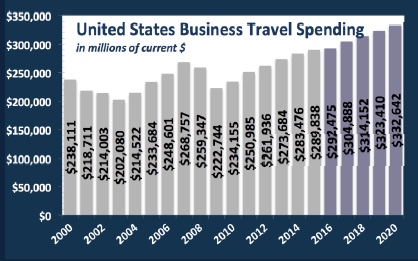Despite the fact that Return On Investment (ROI) is a financial term, in corporate travel management, the concept is not only about numbers in expense reports but also about opportunities to build relationships with various groups relating to Profit & Loss for the company. We live in a world of technology innovations turning every facet of business into digital means, from emails to conference calls. However, one thing that hasn’t changed about the nature of business, and even the nature of human beings, is that we rely on face-to-face communication. Business travel plays a key role in corporate strategy to drive revenues and enhance competitive advantages by enabling face-to-face meetings, no matter if the economy is in a recession or in recovery [PDF].
Your Customizable Travel Policy Template
A white paper released by Oxford Economics USA in 2009, The Return On Investment of U.S. Business Travel [PDF], reveals, “both executives and business travelers estimate that 8% of current business would be lost without in-person meetings.” The ratio of ROI seems to present a way of expense measurement and costs management to some senior managers, such as CFOs. Going beyond the math formula, corporate travel managers should understand that business travel consolidates relationships and networks within and outside of the company. For fulfilling this commitment, corporate travel managers have to create a metric to maximize and measure the returns and the investment in order to help weigh the benefits of in-person meetings and other travel purposes with the costs of travel.

Return on Investment, simply put, is a performance measure tool to evaluate efficiency of an investment, namely, the amount of return (or benefit) on an investment relative to the investment’s cost. The white paper from Oxford Economics USA indicates that business travel could be perceived as a capital investment that “is expected to yield benefits to corporate productivity.”
ROI reflects the real value of business travels to individual companies and the U.S. economy. When a business travel budget comes under greater scrutiny in an economic recession or company downturn, the investment of business travel “needs to be justified based on the return of revenue growth and the bottom-line profits that they produce,” said U.S. Travel Association president and CEO Roger Dow, in an interview with Business Travel News. “Every business leader wants to know what can we cut today and what can we cut that is not going to hurt our business today and not sacrifice our growth tomorrow.”
On the other hand, the relationship between business travel and company performance is a robust relationship between a business trip and its profitability. Both the white paper in 2009 and a research report in 2012, published on Travel Effect, find that industries and companies that increase business travel spending see growth in consumers and sales. Also, the majority of corporate executives acknowledge that cutting back on business travel would pose significant business risks.
So, let’s break down the definition of ROI of corporate travel into two concepts, investment and benefit, to get an in-depth picture of how corporate travel impacts a company’s profitability and sustainability.
Investment: What Do Companies Invest in Corporate Travel?
The Bureau of Economic Analysis Travel and Tourism Satellite Account (TTSA), Independent Oxford Economics, and U.S. Travel Association uncovered that U.S. companies spent $229 billion on business travel in 2008, and $206 billion was spent on domestic business travel. As the U.S. economy began to recover from the recessi on, companies refueled business travel by spending $299.9 billion in 2016, and business travel spend is projected to hit $310.4 billion in 2017. Spending is expected to hit nearly $357.5 billion USD in 2020, averaging a 3.3 percent annual growth rate per year between 2016 and 2020, according to the Global Business Travel Association (GBTA).
on, companies refueled business travel by spending $299.9 billion in 2016, and business travel spend is projected to hit $310.4 billion in 2017. Spending is expected to hit nearly $357.5 billion USD in 2020, averaging a 3.3 percent annual growth rate per year between 2016 and 2020, according to the Global Business Travel Association (GBTA).
In the white paper from Oxford Economics USA, a survey of 400 corporate executives reveals that their travel expenses and primary benefits come from seven types of business travels:
- Customer visits
- Sales and marketing
- Internal meetings
- Employee training
- Conferences, conventions
- Trade shows, exhibitions
- Incentives and rewards
Clearly, companies still see value in business travel, given the amount of money they are investing. Yet, as business travel spending continues to rise, do the benefits outweigh the costs?
Your Customizable Travel Policy Template
Benefit: Why is Business Travel Beneficial for Company Performance?
Business travel is important for company performance because it is about investing in people, relationship building, and creating profitability — a.k.a., competitive advantages.
There is no doubt that business travel brings a broad range of benefits to a company, directly and indirectly. The U.S. Travel Association analyzes a statistical modeling [PDF] to quantify the return on business travel. It assumes that every dollar spent on business travel yields $9.50 return in revenues and $2.90 in profits in a fiscal year. More than 50 percent of 300 corporate executives surveyed recognize that even in the economic downturn in 2008, cutting back on business travel hurt their companies’ performance. In the meantime, 81 percent of corporate executives believe that a slow economy calls for more contact with clients, not less, as reported by The U.S. Travel Association.
The benefits of business travel go beyond the bottom line to fuel the companies’ competitive advantages on consumer acquisition, employee productivity, and consolidating networking. Business travel represents a substantial force to increase market share as in the following aspects:
- Business travel strengthens consumer relationships and aggregates the consumer base. Whether it involves travelling by train to visit a prospective client, or flying to present in a trade show, business travel is bound with sales. Client-specific travel, in-person meetings, and trade shows are demonstrated to have significant impact on consumer retention.
- Business travel nurtures cooperative relationships within and outside the company through face-to-face meetings. Eventually, the respect and supportive working environment between co-workers and the proactive engagement with business partners and investors, both sometimes aided by face-to-face meetings, help realize immediate profits and secure long-term investment and business partnerships.
- Business travel is “an investment in human capital [PDF]” with benefits such as transparent communication, idea sharing, professional development, and staff retention. Employees also tend to have an emotional bond with the company based on incentive travels. As millennial employees say: play hard, work harder.
Four Strategies for Maximizing ROI for Your Corporate Travel
Even if a company understands the value of business travel, this does not mean it perceives business travel strategically rather than merely looking at the travel expenses in an income statement. The definition of ROI points out two ways to maximize the results, increasing the returns and/or decreasing the investments. Both corporate travel managers and senior managers tend to get more expenses out from the income statement, but they often pay less attention to extending those returns of business travel going from incomes within a defined time frame to enduring assets building.
It is essential for travel managers to manage corporate travel as a strategic investment and to maximize ROI both for short-term profitability and long-term sustainability.
A Clear Policy + Proactive Communication = More Savings
Savings-control is never an easy task, but if you have a clear plan ahead of time and consistently talk to your employees about the company’s travel policies, you’ll see savings.
An effective travel policy guides road warriors to their planned travels smoothly by clarifying preferred vendors, the reimbursement process, travel safety and security procedures, as well as the company’s booking tools and TMC, if applicable. However, if budget owners don’t understand the policy and advanced travel technologies well enough, they cannot realize benefits to the travelers as well as the controlled savings to the company.

Arm your travel managers with information about the travel policy and related technologies, which will help with enforcing the policy. Inform your employees with emails, regular updates, and forums. As long as your travelers know what you prepared for their upcoming travels–from financial discounts to quicker reimbursement and alleviated safety concerns–they’ll take advantages of these policies. Eventually, all your inputs result in improved policy compliance, keeping you from potential travel report fraud, incomplete data, and travel safety crisis. How does this relate to ROI? Policy compliance results in savings, which lessens the amount of money your company spends on its original business travel investment.
Your Customizable Travel Policy Template
Collaborate with Your CFOs to Succeed in Cost-Management
A strong relationship between CFOs and travel managers is key to optimizing the ROI of corporate travel. Regular collaboration between CFOs and travel managers results in getting support to manage travel costs. Why? Because they know not all cuts are smart cuts. And their insights on the travel policy will encourage more compliance and optimize the ROI of business travels.
You want your CFOs to share the same vision of the travel management as you so that they “can help mediate the inherently political nature of travel management and provide critical energy and motivation,” says Pip Spibey-Dodd of Travelport Locomote. Despite the fact that your CFOs may acknowledge, for example, that your travel plans drive company growth, they might still attribute increasing operation costs to things like rising airfares and want to shrink reimbursement options. You have to help your CFOs look beyond operation costs on income statements to what these costs – a.k.a investments – mean in terms of the benefits to the company. So, talk them about the benefits of business travel and its relationship to ROI. Make sure you’re on the same page, as this can have profound effects on the company culture.
Also, help CFOs see the benefits of any changes you may want to make and get them on board before making those changes. For example, an April 2013 Aberdeen Group Report, “End-to-End Visibility Into T&E Expense Management: Mobile Comes to the Table,” shows that investing in an end-to-end solution to travel management results in a 44% improvement in compliance and boosts efficiency in real-time travel and post-travel reporting and analysis. You can use this kind of data to support changes you’re making to improve ROI.
Better Expense Control Means Better ROI Measurements
Controlling expenses and measuring ROI for corporate travel comes with many challenges. For travel managers, buyers, and intermediaries, there are a variety of hurdles such as capturing fragmented travel data, locating the invisible expenses of out-of-policy bookings, and setting up expense reporting systems. In other words, controlling expenses requires you to spend some money to find your solutions, no matter if you want to outsource the process to a travel management company or use robust tools. However, consider money you might spend as an investment with a long-term return on expense-control. By having a cost-effective expense reporting process, you would save yourself time from correcting false information.
In addition to data control, data measurement presents travel managers with a way to know your travelers and adjust your policies or programs to appeal to their needs. By collecting complete and accurate data regarding their health lifestyle, for instance, you can negotiate with a branded resort or hotel with an award-winning fitness center for deeper discounts because you know that your travelers would stay in the hotel providing the great fitness center. The key to having better ROI on data and expense control processes and technologies is to know your travelers’ needs and how your data strategies would affect the travelers.
Unlock Returning Road Warriors’ Travel Experiences to Maximize ROI
You can improve your ROI through the lens of your returning road warriors who bring valuable feedback and intelligence with them. To make your travel plans relevant to your travelers’ needs, you can learn how your road warriors reacted to your new list of hotels with those nice fitness center!
Post-trip productivity is an extended facet of ROI from on-the-road activity to back-to-business benefits. You can also leverage your ROI through collaborative learning sessions and workshops in which returning travelers share insights to fuel new ideas. Ultimately, learning from your company’s road warriors gives you more insight into both the “R” and “I” in ROI.

An Important Reminder for Maximizing the ROI of Corporate Travel
When you are looking for efficient ways to optimize your ratio of ROI for corporate travel, don’t forget about the power of the benefits of corporate travel—whether these benefits realize immediate profits or lead to longer-term sustainability. Leverage the experiences of your company’s frequent travelers to help you learn more about these benefits and make sure to share those with your company’s higher-ups. Use data to understand travelers’ needs and preferences and track the company’s business travel investments, but don’t forget that the returns are sometimes intangible.

